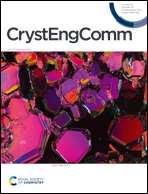Halogen-induced core structural evolution of four dinuclear copper(i) luminescent coordination compounds†
Abstract
The reactions of [Cu(CH3CN)4]ClO4 and 2-(diphenylphosphino)pyridine (dppy) with different halogen reagents NH4X (X = Cl−, Br− and I−) and four luminescent di-copper(I) coordination compounds, namely [Cu2(μ-dppy)3Cl]ClO4·H2O (1a), [Cu2(μ-dppy)3Br]ClO4 (2a), Cu2(μ-Br)2(μ-dppy)(η-dppy)2 (2b) and [Cu2(μ-I)2(μ-dppy)(η-dppy)2] (3b), were isolated. Intriguingly, X-ray crystallographic studies reveal that there were two kinds of Cu2-core structural configuration induced by the differently sized halogen anions. With Cl− acting as a co-ligand, 1a featured a trefoil-like Cu2-core with three μ2-dppy in a head-to-head orientation bridging two Cu(I) and one terminal Cl− occupying one axial position. On replacing Cl− with I−, 3b comprised a butterfly-like Cu2-core, being bridged by two I− anions and one μ2-dppy along with two terminal dppy. When Br− was employed, both the above types of Cu2-cores were obtained in 2a and 2b, respectively. All these four di-copper(I) compounds exhibit intense green photoluminescence with microsecond lifetimes.



 Please wait while we load your content...
Please wait while we load your content...